In this section we cover saltwater fish found off Mayan Riviera and the rich blue water offshore fishing grounds of the Mexican Caribbean. It is an uncomplicated saltwater species guide to help you identify and locate your target fish, advise you on successful fishing methods and their fighting characteristics, and the proper tackle and baits used to catch them. Pesca Maya Fishing Lodge provides you with everything you need for an exciting day of saltwater fishing. Our knowledgeable fishing guides have the experience to offer you an unforgettable day and provide the skills and techniques needed for a successful and enjoyable fishing trip.
Gamefish Descriptions
Riviera Maya Gamefish Descriptions
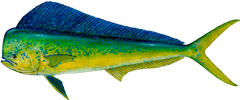
Dorado
Coryphaena hippurus
- Other Names: Dolphin, Mahi Mahi
- Range: Mexican Coastal Waters, Carribbean
Habitat: Dolphin ream the open sea in a continuous hunt for food. Anglers seek them along rafted weedlines and around any sort of large floating object. The location of schools may also be given away by feeding birds, particularly frigate birds. - Description: A blaze of blue and yellow or deep green and yellow when in the water, sometimes shows dark vertical stripes as well when excited. Small dark spots on the sides. Dorsal fin extends nearly from head to tail. Head is very blunt in males (bulls); rounded in females (cows). The Pompano Dolphin, Coryphaena equisetis, is often mistaken as a female or juvenile male Dolphin. It is found in most of the same waters, grows to about 5 pounds, and can be distinguished by the rounded shape of the underbelly.
- Size: Schooling fish run in similar sizes, from around a pound to nearly 20 pounds at times; larger fish are loners or can be found in pairs, bull and cow. Big bulls often reach 50 pounds in weight and can exceed 80 pounds on rare occasions. Large cows generally top out at 40 pounds or so. World record is 87 pounds.
- Food Value: None better.
- Game Qualities: Top of the heap in any weight class speedy. Speedy, strong and acrobatic.
- Tackle & Baits: With the Dorados anything goes. Private boat anglers seek to find a school by trolling or by running and searching for visual signs. Once a school is located it can usually be kept around the boat by restrained chumming with cut bait, and/or by keeping at least one hooked fish in the water at all times. A hot school will eagerly accept jigs and all sorts of casting baits, including flies and popping bugs. If strikes slow down, cut bait often does the trick. Big or wise fish may insist on live bait. Countless Dolphin are also caught, both by design and accidentally, on the entire gamut of rigged trolling baits and artificial trolling lures.
- Fishing Systems: Casting, Drifting, Trolling
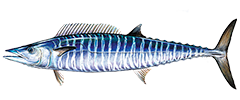
Wahoo
Acanthocybium soladri
- Other Names: Peto, Ono
- Range: Mexican Coastal Waters, Caribbean
- Habitat: Roams the deep blue water, but anglers can find them by working dropoffs, seamounts, weedlines and other favorable feeding locations.
- Description: Long, slender body marked with zebra-like stripes of white and deep blue or black. Mouth is elongated and narrow, and equipped with razor-sharp teeth – careful!
Size: Common at 10-50 pounds; often grows to 80 or 90 pounds; maximum potential about 150 pounds. World record is 158 pounds, 8 ounces. - Food Value: White meat is tasty but rather dry. A good smoking fish.
- Game Qualities: May strike a surface bait in spectacular, greyhounding fashion, but seldom jumps after being hooked. Wild fight is characterized by several sizzling runs, usually at or near the surface. One of the fastest of all gamefish.
- Tackle & Baits: Many Wahoo are hooked on heavy tackle, incidentally in Billfishing. Best choices, however, are light to medium ocean trolling outfits with lines up to 30-pound test; 50-pound isn’t too heavy for good sport with big specimens. A few have been caught by deep jigging or ocean casting with spinning and baitcasting tackle – even fly tackle on rare occasion. Most productive bait is a weighted feather or similar trolling lure, rigged in combination with a whole small baitfish or large strip. Surface trolling is sometimes effective, but deep trolling is much more likely to produce a Wahoo.
- Fishing Systems: Drifting, Trolling
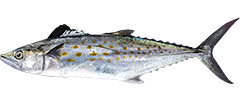
Sierra
Scomberomorus maculatus
- Other Names: Spanish Mackerel
- Range: Mexican Deep Waters, Eastern Pacific, Caribbean
- Habitat: Largely coastal, but roams offshore at times.
- Description: Dark above with silvery sides. Many spots, which are both yellow and brown. The body is proportionately deeper than with juvenile King Mackerel and the yellow spots appear rounder and brighter, but if in doubt, the only true identifier is the lateral line, which tapers rather gently from front to back with no severe dip.
- Size: Common at 1-3 pounds; not too unusual at 5-7 pounds; maximum potential over 10 pounds. World record 13 pounds.
- Food Value: If you like rich, rather dark fillets, they are great broiled or skinned and fried. Good smoked, too.
- Game Qualities: Outstanding on light tackle, very fast runs.
- Tackle & Baits: Spinning, baitcasting and fly outfits. Spinning is often best, because the faster retrieve of a spinning reel is sometimes needed to move a lure at a pace that will interest the Mackerel. Best lures are small white nylon jigs and silver spoons, but many others work, including topwater at times. Flies should be small with lots of flash. Best bait are small silvery baitfish, live shrimp and drifted strips.
- Fishing Systems: Drifting. Still Fishing. Trolling.
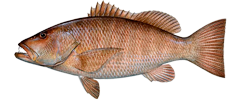
Snapper
Lutjanus buccanella
- Other Names: Blackspot Snapper, Bahamas Red Snapper
- Range: Mexican Pacific Ocean, Sea of Cortez, Caribbean
- Habitat: Nearly all are caught along outside dropoffs at depths of 200 feet or greater. Roams the deep blue water, but anglers can find them by working dropoffs, seamounts, weedlines and other favorable feeding locations.
- Description: Vivid red overall, with black crescent-shaped mark at base of the pectoral fin.
- Size: Averages 3 or 4 pounds; usual maximum is 10 or so. World record 7 pounds, 3 ounces.
- Food Value: Excellent
- Game Qualities: Strong fighter like other Snappers
- Tackle & Baits: Blackfin Snapper generally stay well beyond the depths of anchoring. Most are caught while drifting and jigging off cliffs and ledges. Blackfin eagerly strike a heavy bucktail or nylon jig.
- Fishing Systems: Drifting, Trolling
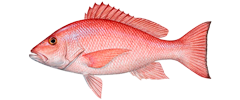
Snapper
Seriola dumerili
- Other Names: Amberfish, AJ, Coronado, Cavilia, Kingfish
- Range: Mexican Coastal Waters, Eastern Pacific, Caribbean
- Habitat: Adults are common at various depths, ranging from reefs several hundred feet deep to fairly shallow wrecks and reefs. Big ones also come close to shore at times, particularly in the Keys and the Islands. Artificial reefs and wrecks all along the Gulf Coast often harbor huge schools of smaller Amberjack, and many Gulf wrecks are home to big ones as well.
- Description: Overall brownish or goldish. Heavy body. No scutes forward of tail fin. Dark oblique line through the eye that ends at the dorsal fin.
- Size: Schools of young fish are common at 5-20 pounds. Average size over deep wrecks and reefs is 30-60 pounds, but 100 pounders are not too rare and the potential maximum exceeds 150 pounds. World record 155 pounds, 10 ounces; Florida record 142 pounds.
- Food Value: Excellent smoked or fresh.
- Game Qualities: A strong, punishing fighter that powers deep and defies lifting. Fairly long runs can also occur early in the fight. A great deal of stamina matches their strength. Novices may fight Amberjack of average size for an hour or longer.
- Tackle & Baits: Amberjack are most often caught aboard charterboats and partyboats, on heavy rods and reels with lines testing 50 pounds or more, and are no patsies even then. Experienced light-tackle anglers can successfully battle them with spinning and baitcasting rigs, and even fly rods. Around wrecks, they frequently follow hooked fish to boatside, and also may rise to the top voluntarily, rhen they can be cast to with surface plugs, spoons, jigs, or big flyrod streamers and poppers. Live chum will also draw Amberjack from the depths. Best bait with heavy tackle is any sort of live fish, the friskier the better.
- Fishing Systems: Casting, Drifting, Trolling
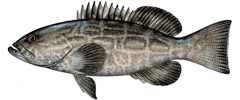
Grouper
Mycteroperca bonaci
- Other Names: Bonaci, Arara, Aguaji, Mero
- Range: Mexican Coastal Waters, Pacific Coast, Deep Waters, Caribbean.
- Habitat: Groupers of many sizes and varieties are commonly found around the edges of coral reefs and rocks, from about 30 feet of water out to the deepest dropoffs. Even big fish, however, may roam to much shallower patch reefs, especially in cooler seasons. Small Blacks may also frequent creeks in some areas.
- Description: Overall color is dark gray. Markings are blacker than those of the Gag, and form box-like patterns. Fins are black, their edges also black or deep blue.
- Size: The largest of our Mycteroperca groupers, the Black, frequently exceeds 50 pounds in weight and can top 100. World record 114 pounds.
- Food Value: Excellent. Yum Yum!!
- Game Qualities: Nice fighter – Black Groupers are considered the best of the family.
- Tackle & Baits: For all-around work, ocean gear with lines of 30-pound test or higher gets the call. Light tackle fishermen in Banderas Bay, however, have caught many Blacks over 50 pounds. One key, besides a huge helping of luck, is to hook the fish while drifting instead of at anchor. The drift of the boat adds to the power of the tackle and just might help drag the big fish far enough away from his rocky “hole” that he cannot get back. For drifting or still fishing, the best baits are frisky live fish such as Blue Runners or other small jacks. Pinfish and Pilchards are good too, as are Mullet heads and other large cut baits. Best casting lures are leadhead jigs, weighing from 1-4 ounces, depending on depth. Trolling over the reefs with rigged, swimming Mullet, feather-and-strip combos, and large plugs also takes many.
- Fishing Systems: Drifting, Still Fishing, Trolling
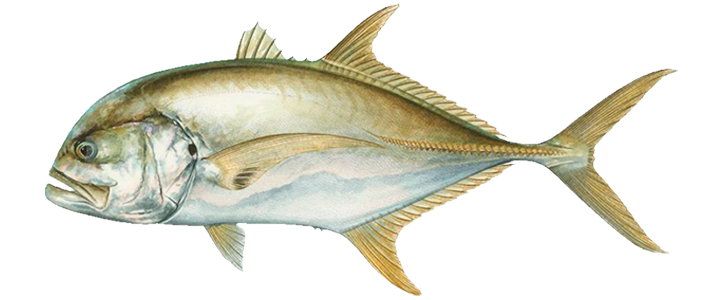
Crevalle Jack
Caranx hippos
- Other Names: Jack Crevalle, Crevally
- Range: Mexican Coastal Waters, Eastern Pacific, Caribbean
- Habitat: The Crevalle may show up at any time in virtually all Mexican waters, from the deep reefs to well up coastal rivers. Usually runs in schools and the smaller the individual fish, the larger the school. The biggest Jacks often cruise in pairs and are usually found in or near major inlets and around offshore wrecks and reefs of both coasts, but may come into deep bays and canals where they chase Mullet and often herd the prey against seawalls. Banderas Bay has a large population of this species.
- Description: Deep, compressed body. Blunt head with black spot on rear edge of gill cover. Hard scutes forward of sickle-shaped tail. Color usually yellowish with white undersides.
- Size: Common at 1 pound or less to about 5 or 6 pounds. Plentiful up to 12 pounds in most areas. Sometimes tops 20 pounds and can reach 50 pounds or even more. World record is 57 pounds.
- Food Value: Poor by most tastes. Most of the meat is dark red and of strong flavor. A delicasy for our fine finned friends however.
- Game Qualities: Few fish can out-pull a Crevalle of equal size. The fight is unspectacular but dogged, the usual pattern being a long first run. Jacks use their flat sides to good advantage when waging a tug-o-war.
- Tackle & Baits: Most Jacks are fairly small and are caught on the full range of light tackle by anglers seeking other game. If you target larger Jacks, say 10 pounds or more, sturdy spinning, baitcasting and fly tackle should be used, with lines no less than 8-pound test. Small Jacks, such as those frequently encountered on shallow flats, will gulp down almost any sort of natural bait, live or dead, as well as all the popular casting and flyrod lures. Big Crevalles, however, generally like their meals moving very fast. To assure hookups, you have to use fresh and frisky live fish, or retrieve your artificial lures rapidly, noisily, or both. Topwater plugs are good, as are fast-whipped jigs. Fly rodders often have to work very hard, stripping their streamers or poppers as fast as their elbows will move.
- Fishing Systems: Casting, Drifting, Still Fishing, Trolling
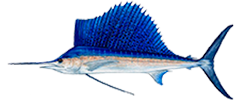
Sailfish
Istiophorus platypterus
- Other Names: Atlantic Sailfish, Spindlebeak, Pez Vela
- Range: Mexican Coastal Waters, Eastern Pacific, Caribbean
- Habitat: Like the other Billfishes, the Sailfish is considered an ocean species, but generally can be found closer to land than the rest, seeming to prefer areas where coral reefs and/or freshwater runoffs mingle with ocean water.
- Description: Upper surfaces usually dark blue to black, silvery below, vertical stripes often visible on sides.
- Size: Averages 30-60 pounds, but many under 30 pounds and a few up to 100 pounds are also taken. World record 221 pounds.
- Food Value: Very good broiled or smoked, and should be kept if inadvertently killed. Protected commercially.
- Game Qualities: Unsurpassed in its size range for combined strength and spectacle.
- Tackle & Baits: Light ocean trolling or heavy spinning outfits with lines up to 30-pound test; 12 and 20 pound lines are adequate in experienced hands and provide great sport. In Southeast Florida, live-baiting, either by kite fishing or flatline drifting, has become perhaps the most popular approach to sailfishing, with Blue Runners, Goggle-eyes, Pilchards or Pinfish being the common offerings. Historically, most Sailfishing has been done with rigged trolling baits, mainly Ballyhoo and strips of Bonito or other small fish. Many Sailfish have been caught on jigs and on drifted Ballyhoo/jig combinations. Fly casters have also taken them on occasion, but Atlantic sails do not decoy as readily as their Pacific counterparts and so fly fishing for them has not become very popular, despite the fact that science has proclaimed the Sailfish of both oceans to be the same species.
- Fishing Systems: Occasionally Casting, Drifting, Trolling
For more details please check out our fishing opportunities in Ascension Bay
See more Fishing in Ascension Bay pictures from our Gallery



